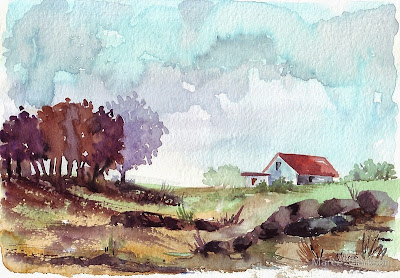W&N watercolour on DalerRowney 220gsm (135lb) Smooth heavy-weight sketching paper, no preliminary sketching
Trees are the Earth’s Endless Effort
To Speak with the Listening Heaven.
- Rabindranath Tagore, ‘FireFlies’
Trees are living, breathing creatures. The fact that trees are, in many ways, like intelligent beings may come as somewhat of a surprise to you. This can be explained as follows:
- 1. A tree eats. Its tiny hair like roots beneath the earth’s surface are always on the hunt for such elements in the soil as nitrogen, calcium, phosphorus, potassium, iron, copper, zinc, and magnesium.
- 2. A tree drinks. A generous supply of water is required for carrying nutrients from the soil through the “digestive system” of the tree.
- 3. A tree digests its food. A tree has a digestive tract. Like a plumbing system, it functions as elements from the soil flow through microscopic ducts in the sapwood from the tiniest of root hairs to the most distant of leaves where tree food is formed on contact with sunlight and C02. The food is then carried through the tree to build up layers of cells in the cambium (the inner skin or growing tissue). Tree growth and root development result.
- 4. A tree breathes. Like all living matter, a tree requires air. A hard, packed soil at the base of the tree will cut off the tree’s breathing. Supplies of oxygen and carbon dioxide vital to the manufacture of food are absorbed through the soil by the roots, as well as from the atmosphere by the leaves.
- 5. A tree reproduces. The tree is capable of rearing its own family. Many seeds have wings that, with an assist by winds, carry them to points away from the parent tree. There, soil and sunlight sufficiently permit new, fast growth.
- 6. A tree “talks.” Listen to trees the next time the leaves rustle in the wind. Thomas Hardy confirmed this when he wrote, “At the passing of a breeze the fir trees sob and moan, the ash hisses the beech rustles.”
- 7. A tree sleeps. In the winter months, when deciduous trees lose their leaves and the growing processes of evergreens slow down, a tree is getting its rest.
- 8. A tree has healing powers. A scar, if properly treated, will always heal as long as the tree is alive and growing.




















